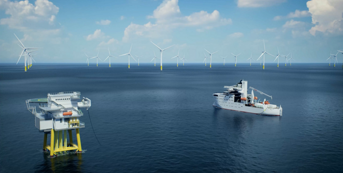Overcoming technological barriers to realize all-electric SOVs
Vard Electro is driving progress towards realization of fully electric service operation vessels (SOVs) by putting in place offshore charging stations alongside existing onboard technologies to facilitate zero-emission maintenance operations at offshore wind farms.
29. August 2023

Battery-driven power and propulsion systems are seen as the optimal solution to minimize the environmental footprint of SOVs, which are used for crew transfers and logistics in relation to turbine maintenance and account for a high proportion of emissions in wind farm operations.
There are now strong regulatory and commercial drivers for construction of battery-powered ships, given the increased cost of using pollutive fossil fuels as a result of implementation from 2024 of the EU Emissions Trading System (EU ETS) for shipping that ultimately could include offshore vessels, as well as more stringent global emissions regulations such as CII.
Commercial gains from battery power
Emissions performance is seen by wind farm operators as a key technical and commercial competitive parameter in tender rounds for SOV charters. There is also growing pressure from banks and investors for green vessel capacity to cut emissions across the value chain as a condition of wind project financing, as well as from other stakeholders such as NGOs.
While the initial capex for a battery-powered SOV is relatively high, this will deliver commercial benefits in the longer term due to higher costs for emissions and improved energy efficiency that cuts operational expenses", says Øystein Longva, Chief Technology Officer in Vard Electro
All-electric ships with energy storage in large batteries with optimized power control can significantly reduce fuel costs, maintenance and emissions. This also results in increased vessel responsiveness with improved safety and regularity in critical situations.
Vessels running on battery power have improved seakeeping and manoeuvring performance due to a more dynamic response capability from instant current, compared with a diesel generator that needs to ramp up. They also require less maintenance as there are no moving engine parts, which reduces noise and vibration, according to Vard Electro’s Product Manager Power & Propulsion, Jogeir Skinnes.
Along with smart dynamic positioning with more efficient use of thrusters to enhance station-keeping, these factors can enhance overall efficiency as well as widen the operational window for a battery-driven SOV, he says.

All-electric ships will deliver commercial benefits in the longer term due to higher costs for emissions and improved energy efficiency that cuts operational expenses
– Øystein Longva, Chief Technology Officer in Vard Electro
Offshore charging in the wind
There have been major advances in battery technology in recent years, with lithium-ion batteries optimized for energy density, lifecycle, cold weather performance, robustness and safety, while costs have been reduced significantly.
Increased battery capacity has resulted in wider application in the maritime industry, with the first all-electric battery-powered car ferry, Norled’s Ampere, brought into operation in 2015 and battery energy storage systems installed on a number of offshore supply vessels.
Longva points out that all the onboard technologies are now in place for fully electric SOVs, with Vard Electro delivering energy storage as well as power management and automation systems as part of its SeaQ product range.
The marine electrical systems supplier is now addressing the final technical obstacle - offshore charging - through its joint leadership of the industry research project Ocean Charger launched earlier this year to test, validate and commercialize new technological solutions for energy transfer to battery-powered vessels offshore.
The project aims to lay the groundwork for green maritime infrastructure as part of future wind development by facilitating charging points at offshore substations connected to wind farm power grids that would enable SOVs to charge batteries with minimum additional energy sources.
Longva points out that such a solution would fit well with the operational profile of SOVs due to proximity to a renewable power source for recharging while working at wind farms. This would also overcome the barrier of limited operational range for fully electric vessels working at long distances from shore-based power supplies.
Keen industry interest set to spur orders
A full-scale test of the offshore charging solution is planned for early 2024 amid keen interest in the project from wind farm operators and Vard Electro is looking to take orders for charging stations already next year, according to Longva. “Few components are required for offshore charging stations so this technology could be scaled up rapidly,” he says.
Vard Electro has opted for high-voltage AC charging with 11kV as the optimal offshore charging solution for such vessels as this can deliver increased energy with reduced size and number of cables compared with DC sources, giving one day of operations from a three-hour charge at 6.3 megawatts per hour through a single cable.
Skinnes says that larger energy batteries are the preferable power sources onboard an SOV as they provide sustained lower output over a longer period of time and have higher capacity than power batteries, which are typically used for smaller solutions with demand for relatively higher power output, but for shorter periods. A further benefit is that energy batteries require less cooling than power batteries.
The elimination of diesel engines does though mean the benefit of heat generation from such engines to provide the heating needs of the vessel will be lost, which will place higher demands on battery capacity for energy production to cover this requirement.
In combination with an AC system, energy batteries can provide an effective spinning reserve for dynamic positioning operations and their cell chemistry provides higher energy density with more kilowatt hours per square metre, he explains. Furthermore, the LTO and LFP chemical composition of energy batteries is safer with less turbal runaway than power batteries using NMC (Nickel Manganese Cobalt Oxide) cathodes, he adds.

Alternative fuel to provide energy reserve
Longva says there are safety challenges with offshore charging, particularly with hazards related to connection and disconnection of power cables in rough weather and high sea states, though he expects these to be largely resolved through testing next year. He points out that shuttle tankers have been bunkering with buoy-loading operations for years so this is a familiar concept in the offshore sector.
In addition, fully electric SOVs will initially need to have installed onboard a back-up energy reserve to provide ‘take me home’ functionality in the event they cannot recharge at sea due to difficult weather conditions or other adverse factors. This is likely to entail emergency generator sets (gensets) running on alternative fuels such as methanol, hydrogen or ammonia, or alternatively fuel cells that typically use hydrogen.
While hydrogen and ammonia are technically feasible, there are drawbacks with these fuel types in terms of safety, availability and storage, according to Skinnes.
The low energy density of hydrogen means that it requires between six and 10 times more storage space onboard than conventional fuel oil, leading to higher costs for storage facilities, and it also has safety issues due to high flammability. In addition, there is a lack of hydrogen infrastructure for shipping, making the fuel more suitable for smaller coastal vessels such as ferries that can refuel regularly using local bunkering facilities.
While ammonia is easier to store than hydrogen, it is a toxic and corrosive substance that is typically being used for fuel on specialized vessels carrying ammonia as cargo and is not considered suitable for SOVs. Fuel cells are a more viable option but are ruled out as an alternative energy source for such vessels due to their prohibitive cost.
Methanol infrastructure requirement
This essentially leaves methanol as the best alternative fuel for emergency gensets on fully electric SOVs, given storage and handling of methanol is well-known in the offshore market and the fuel is more easily accessible than other low-carbon fuels.
There is increasing uptake of methanol as a marine fuel, with 25 methanol-fueled ships in operation and another 81 ships on order, DNV states in its latest Transport in Transition report. However, the fuel remains expensive as the supply infrastructure remains under development and will take some years to scale up to meet the demands of global shipping.
Only fossil-based methanol is currently available for bunkering and there is no dedicated bunkering infrastructure for the fuel. However, as it is a commonly traded product, there are 118 methanol terminals for local storage in connection with ports that could be used for bunkering with limited modifications, according to DNV.
While methanol technology is in place, it will require significant investments by shipowners in newbuilds and fuel suppliers in bunkering infrastructure to develop the value chain for methanol and thereby bring prices down to make the fuel a cheaper alternative for shipping.
“It is costly to implement green methanol technology and this means first movers are needed both on the consumer and supplier side to accelerate development. This would help to resolve the dilemma of which comes first - ships using methanol or bunkering facilities,” Longva says.
Powering up SOV newbuilding activity
He states effective deployment of all-electric SOVs at wind farms will also require enhancement of the operational profile of these vessels to maximize energy efficiency, which would entail optimization of speed relative to power consumption and improved route planning.
Longva believes that development of offshore charging infrastructure will provide an important pathway to incentivize investments by shipowners in fully electric SOVs and thereby accelerate newbuilding activity in this shipping segment.

SeaQ Power
A complete set of power solutions and components that generate, distribute, and control power onboard vessels.

Offshore Charging
With a strong consortium of industry and research partners, VARD will lead the way from research to testing, validation, and commercialization of new technological solutions for energy transfer to battery-powered ships offshore.

DC Switchboards taking the charge in shipboard power systems
Sees plug-in potential for green energy sources as industry faces AC/DC dilemma on transmission networks.